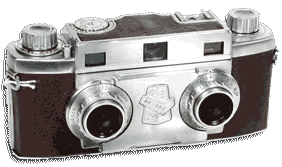
Approx. date of manufacture: 1953
Approx. original price: $179.50
Approx. street value: high-moderate
Revere is mostly known for its movie cameras, and they competed tooth and nail through the 50s with Bell & Howell for the amateur movie market. They made a couple of still cameras, but the only ones of note are the Revere Stereo 33 and the Wollensak Stereo 10. I always wanted the latter but I still can't afford it. Revere owned Wollensak and used the name the way Toyota uses Lexus: a Revere was the value line and Wollensak was the luxury line; so a Wollensak was a Revere with better lenses. In fact, if you look at the logo in-between the lenses, you'd see it's a foil label that sits in little depression. The two logos are so similar that both of them will fit into that same depression and look equally at home.
I finally got a Revere and declared myself happy enough. I doubt I'd ever shoot with the lenses wide-open anyway, so the extra stop of speed is wasted. I believe that Wollensaks were four element lenses and the Reveres had only three elements; but if I want great optical quality, I'll shoot full-frame 35mm pairs with one of my better cameras.
Nice camera. The three main American cameras of the period, in terms of quality and usability, were the Realist, the Kodak and the Revere (the TDC cameras were German imports). These guys all had fully manual exposure settings, adjustable focus lenses, and the ability to sync with flash and accept standard filters, which makes them pretty versatile. Unlike the Kodak, the Revere put its viewfinder above the lenses so you had parallax problems with close-ups, but made up for it by incorporating a rangefinder—something the Kodak lacked. I doubt many people shot close-ups with these cameras anyway (because stereo-separation becomes a problem), so I don't think parallax error was much of a concern.
One of the interesting things about these cameras is how they focus their lenses. Since you have two lenses you have to make sure they both focus at the same plane. The Kodak had the lenses tied together with a metal band so that one turned the other. This Revere has both lenses mounted on a front standard, and the standard moves forward and backward view-camera style.
This one also has an accessory shoe so you could mount a light meter or a flash.
The camera went out of production in the late 50s but you still get the lens assemblies at surplus outlets all over, so if your camera focusing or lens assembly dies, you can replace it with a NOS (new old-stock) assembly. Try that with your Kodak.
Camera manual: Orphan Cameras.com



